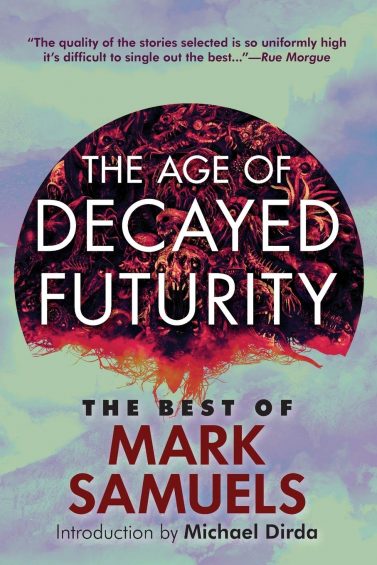 By MARK SAMUELS (Hippocampus Press; 2020)
By MARK SAMUELS (Hippocampus Press; 2020)
A collection that proclaims itself “the best of” horror story maestro Mark Samuels. I don’t agree with that assessment (I say Samuels’ best work is found in the 2010 collection THE MAN WHO COLLECTED MACHEN, only two stories from which are included here), but THE AGE OF DECAYED FUTURITY is eminently worth reading nonetheless, being an excellent showcase for its author’s considerable talents.
Samuels is in the same class as Thomas Ligotti. In fact, in many respects Samuels is the superior writer, having a much greater range (speaking as a longtime Ligotti admirer, I have to admit his writing is a bit repetitive). His tales drip with old world splendor, but evince a modern and even somewhat futuristic air (as summed up by the title), being the logical evolution of the bent universe of Lovecraft and Machen.
The Lovecraft connection is perhaps most evident in this book’s shortest tale “The Black Mould,” which can be viewed as a modern-day rewrite of “The Fungi from Yuggoth.” Also collected here is “Mannequins in Aspects of Terror,” involving a profoundly creepy art exhibit comprised primarily of mannequins (and, of course, mould). The title story is a most unique exploration of celebrity, ego and (as one character states) “the nature of time itself,” while “Apartment 405,” perhaps my favorite of the book’s tales, is about a hapless medical student who unwisely assists the disturbed occupant of the Parisian apartment next door, leading to a horrific series of events that include a mysterious disappearance and sleepwalking, and involve a windowless room containing a strange mirror.
Also featured is Samuels’s most famous story “The White Hands,” presented in the form Samuels considers “most satisfactory” (as “For editorial reasons it was not possible to include the complete text” in the story’s initial edition). It concerns a character, one Alfred Muswell, who’s seemingly patterned after Samuels himself, having authored a book called THE WHITE HANDS AND OTHER TALES, a title that just happens to be very close to that of one of Samuels’s own collections (which for the record was called THE WHITE HANDS AND OTHER WEIRD TALES). Muswell claims to have been guided in the writing of his tales by a long-dead woman before passing on himself, leaving the first person protagonist, who isn’t dissimilar to Muswell (or, presumably, Samuels) in his solitary and obsessive bent, to ferret out the truth about Muswell and his apparently undead muse.
Solitary protagonists and convoluted supernatural mysteries are recurring elements in most of the stories collected here, and in Samuels’s fiction overall. So too the elegant prose and fecund imagination displayed in these tales, which may recall the aforementioned likes of Machen, Lovecraft and Ligotti in many respects, but are ultimately unique to Mark Samuels.
